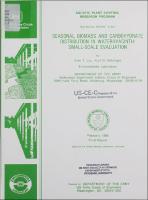Please use this identifier to cite or link to this item:
https://hdl.handle.net/11681/6322| Title: | Seasonal biomass and carbohydrate distribution in waterhyacinth : small-scale evaluation |
| Authors: | Luu, Kien T. Getsinger, Kurt D. |
| Keywords: | Biomass Development Carbohydrate Eichhornia crassipes Waterhyacinth Aquatic plants Seasonal variations Free sugars Starch Total nonstructural carbohydrate Aquatic Plant Control Research Program (U.S.) |
| Publisher: | U.S. Army Engineer Waterways Experiment Station |
| Series/Report no.: | Technical Report (Aquatic Plant Control Research Program (U.S.)) ; no.Technical Report A-90-1 |
| Abstract: | A better understanding of aquatic macrophyte growth cycles and identification of physiological weak points in those cycles are essential for improving the effectiveness of present control techniques of nuisance aquatic vegetation. Application of control tactics at weak points in the target plant's growth cycle should maximize control effectiveness. The objectives of this study were to identify potential physiological weak points in waterhyacinth (Eichhornia crassipes (Mart.) Solms) based on seasonal carbohydrate allocation. Waterhyacinths were grown in outdoor tanks at the US Army Engineer Waterways Experiment Station, Vicksburg, MS. Uncrowded, open-water conditions were maintained by periodic removal of plants to allow room for continuous ramet production. Monthly plant samples, obtained from June 1987 through November 1988, were separated into plant parts (leaves, petioles, membranes, stem-bases, stolons, roots, and inflorescences) to measure carbohydrates (free sugars, starch, and total nonstructural carbohydrates (TNC)) and dry weight in each structure. Data were analyzed to compare levels of carbohydrates and dry weight among plant parts in each month and to evaluate seasonal changes in these parameters for each plant part. May/June and late October were the two periods of extensive ramet production. Maximum biomass was measured in early to mid-September. Peak flowering occurred from late August to early September. Dry weight proportion of leaves plus petioles was in the order mature 𝘑 old 𝘑 young. Dry weight proportions of mature and old petioles were often greater than those of mature and old leaves, while the reverse occurred in young petioles and leaves. Roots accounted for a higher proportion of plant weight (23.0 to 38.8 percent) in blooming and postblooming plants than in preblooming plants (8.1 to 22.3 percent). Significant seasonal changes in dry weight were found in leaves, petioles, membranes, and stem-bases. Highest carbohydrate levels were found in stem-bases from July through November, and in mature leaves in other months. Roots and young petioles had lowest concentrations of starch as compared with other plant parts. Significant seasonal changes in carbohydrates were observed in mature leaves, young and mature petioles, stem-bases, and stolons. Blooming rachises contained the highest level of free sugars (22.8 percent) found in the entire plant. The TNC of whole plant analysis ranged from 3.4 to 9.6 percent. Waterhyacinths store maximum carbohydrates in the stem-base during the September to October period. Starch and sucrose were the main components of carbohydrate reserves in stem-bases. Information on seasonal biomass and carbohydrate distribution demonstrates the important role of stem-bases in the winter survival of waterhyacinth. Potential weak points in the growth cycle of waterhyacinth include the period shortly before mid-September or midOctober, when plants are actively translocating carbohydrates to stem-bases, and in early spring, when weather is warm enough for young ramet emergence and carbohydrates in stem-bases are low. |
| Description: | Technical Report |
| Gov't Doc #: | Technical Report A-90-1 |
| Rights: | Approved for public release; distribution is unlimited |
| URI: | http://hdl.handle.net/11681/6322 |
| Appears in Collections: | Technical Report |
Files in This Item:
| File | Description | Size | Format | |
|---|---|---|---|---|
| TR-A-90-1.pdf | Technical Report A-90-1 | 11.39 MB | Adobe PDF |  View/Open |